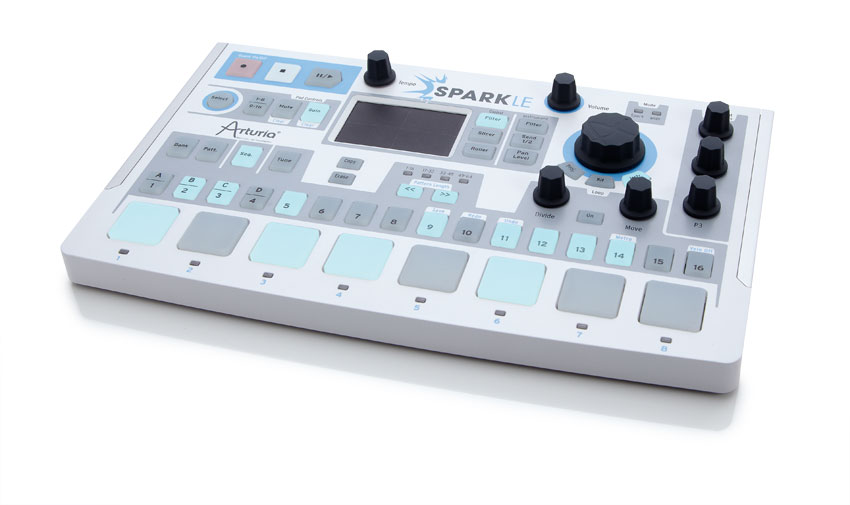

The middle panel is an approximation of the hardware, while the lowest is a repository for mixing and library functions, which also houses the parameters used to edit individual instruments. At the top is the sequencer, in which patterns of up to 64 steps are created and, if required, organised into songs. Simplicity is the key, and this translates to just three panels of drum-related options. I therefore recommend checking the earlier SOS review at /sos/sep11/articles/arturia-spark.htm to get a feel for the synthesis and sample-playback functions on offer. The software's graphics are tailored for the attached hardware, but the functionality is consistent. Lacking this display, the SparkLE might seem at a disadvantage, but in typical use I doubt the loss will trouble anyone hugely.

Without a USB connection breathing life, both controllers merely look decorative, but with the larger model you could practically fool yourself that you were handling a stand-alone drum machine, able to select kits, projects and instruments via the small but serviceable display. In our September 2011 review of the SparkLE's forerunner, we saw that the hardware consisted of dedicated pads, knobs and buttons for the Spark software.
#ARTURIA SPARK VS SPARK LE PLUS#
The Spark LE software's main user interface, plus a few extras such as Accent and Shuffle A soft carry-case is supplied, which you'll appreciate when taking it out to play.
#ARTURIA SPARK VS SPARK LE SOFTWARE#
Fortunately, the software continues to run smoothly if you accidentally pull the plug. That's not the most rock-solid way to attach any device, and its inclusion could mean that the SparkLE isn't thrown around as wildly you might comparably slim controllers (such as the Akai MPC Studio). Bus-powered, its single connection is a mini-USB port on the left-hand side. In practice, the SparkLE feels like a drum machine and handles like one.Īt just 17mm high, the SparkLE has no room for MIDI ports it really is an in-the-box experience from start to finish. you can mute and solo multiple voices, which is far better than on those machines that take 'solo' rather too literally. Mute and solo functions are sensibly implemented, too: ie. With two pad banks to choose from, you have playable access to 16 separate percussion voices in every kit. Actually they're better than that: their velocity and polyphonic aftertouch response encourage performance nuances that leave classic drum boxes in the dust. Although there are still only eight drum pads to hit, they are solid enough to endure the most frenzied finger-tapping.

Otherwise, there are fewer compromises than you'd expect.Īrturia have wisely retained the touch-sensitive FX Live pad, its six buttons the gateway to global or instrument-level tweaking. Also, there are just a single set of instrument-tweaking knobs compared to the eight independent sets of its big brother. If you're fixated on replicating the feel of stand-alone drum machines, the SparkLE won't quite do it you must keep an eye on the computer screen for many operations. The SparkLE is a slender slip of a thing compared to the first model, but the most obvious operational difference between them is the new machine's lack of display. The blue backlit buttons are the only possible source of uncertainty, being slightly spongy, but they're only slightly more so than those of my Korg ESX1, which have lasted for years. With a footprint that's smaller than a sheet of A4 paper and without the ungainly plastic legs of the original, the SparkLE is compact and robust. Seeking to trim off that 'almost' and to lighten shelves and laptop bags everywhere, Arturia have combined the same wide resource of beats and percussion with a cheaper and more petite controller. Its size represented either the spacious, ergonomic drum controller of your dreams or a challenge to squeeze in somewhere, but, sonically, the cool collection of modelled and sample-based kits was almost irresistible. The Spark was large, knobby and brought tactile performance to the purely software environment. Having already given the world a range of modelled analogue synthesizers, adding a drum machine to the family made perfect sense for Arturia. In many ways, Arturia's Spark 'Creative Drum Machine' was a logical extension of previous controller/software partnerships. It's cheaper and more compact - but does the Spark spirit remain? Arturia have pared down their hybrid drum controller.


 0 kommentar(er)
0 kommentar(er)
